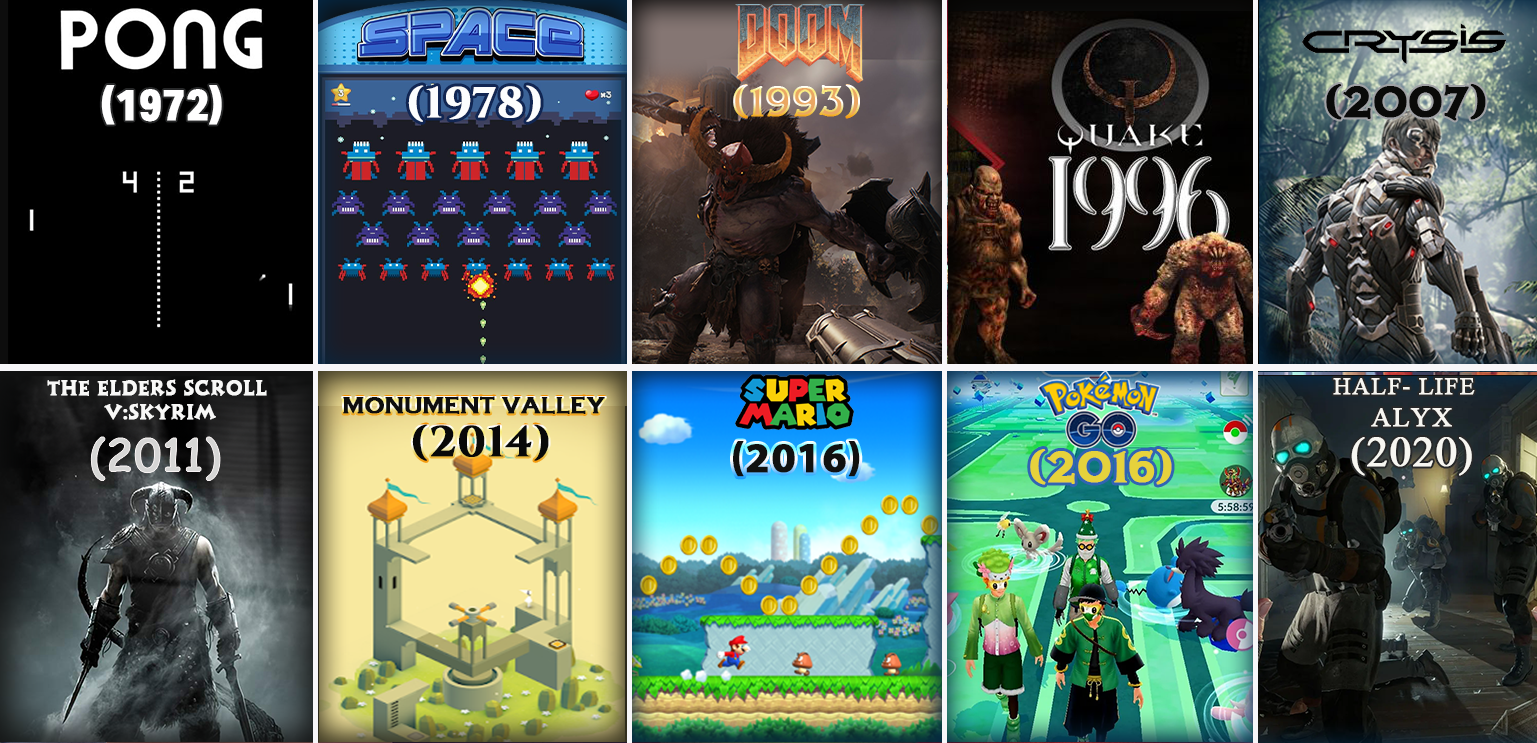Game engines are the essential frameworks that power modern video games. These sophisticated software platforms provide the tools needed to build everything from stunning visuals and fluid gameplay to immersive soundscapes and dynamic world-building. Over the years, game engines have evolved tremendously, shaping the gaming industry and making it possible to develop games with cutting-edge technology. Let’s take a closer look at the history of game engines and how they continue to drive the future of gaming.

The Early Days: Simple Beginnings
In the infancy of video games, developers faced numerous challenges in creating games that were fun, engaging, and functional. During the 1970s and early 1980s, developers created custom-built game engines tailored to the specific needs of their projects. Early games like Pong (1972) and Space Invaders (1978) relied on these rudimentary game engines to handle gameplay logic, visuals, and sound. These engines were limited in their capabilities, often running in 2D with basic visuals and sound effects. However, they played a crucial role in shaping the foundational concepts of game development.
As technology progressed, so did the complexity of game engines. In the late '80s and early '90s, developers began creating more sophisticated engines that could support better graphics and more complex game mechanics. This era marked the start of the shift towards greater versatility in game development.
The Rise of 3D Graphics (1990s)
The 1990s was a pivotal decade in the history of gaming, as it brought with it the dawn of 3D graphics. Game engines were now required to support the rendering of three-dimensional environments, models, and animations. One of the most notable early 3D engines was id Tech, which powered groundbreaking titles such as Doom (1993) and Quake (1996). These engines introduced many features that we take for granted today, including texture mapping, real-time lighting, and polygonal models.
The introduction of the Unreal Engine in 1998 by Epic Games further accelerated the transition to 3D gaming. Unreal Engine’s ability to create detailed, immersive worlds changed the course of game development, allowing developers to build complex environments and lifelike characters with unprecedented ease. The Unreal Engine was a game-changer in terms of graphics, sound, and gameplay mechanics, providing a powerful platform for developers to build games that were visually appealing and technically advanced.
The introduction of 3D graphics marked the beginning of a new era in gaming, where players could explore vast virtual worlds and engage in interactive experiences with a level of depth and realism previously unattainable.
The 2000s: Powering Next-Gen Consoles
As the 2000s progressed, gaming hardware became more powerful, which in turn placed greater demands on game engines. The introduction of next-generation consoles like the Xbox 360 and PlayStation 3 pushed game developers to create engines capable of handling high-definition graphics, physics simulations, and complex game logic.
During this period, engines like Unreal Engine 3 and CryEngine took center stage. Unreal Engine 3, released in 2005, allowed developers to create massive open-world environments, realistic animations, and intricate storytelling. Its cutting-edge graphics technology enabled high-definition textures, detailed character models, and cinematic-quality lighting effects, resulting in a new generation of visually stunning games.
CryEngine, developed by Crytek, was another standout engine that pushed the boundaries of graphical fidelity. It introduced real-time rendering techniques and dynamic lighting systems, creating games with breathtaking environments and lifelike physics. These advancements led to the rise of AAA games, including titles like Crysis (2007), which showcased the full potential of next-gen hardware.
The 2000s saw the emergence of huge, sprawling open-world games like Grand Theft Auto IV (2008) and The Elder Scrolls V: Skyrim (2011). These games set a new standard for production values in gaming, combining impressive visuals, complex gameplay mechanics, and engaging narratives.
The 2010s marked a significant shift in how games were developed and accessed by players. Advances in technology made game development more accessible to indie developers and smaller studios, who were no longer reliant on expensive, proprietary engines. Engines like Unity and Unreal Engine 4 allowed creators to build professional-quality games without the need for massive budgets or teams of specialists.
Unity, in particular, revolutionized the industry by enabling developers to create games for multiple platforms simultaneously. The engine allowed for the development of games for consoles, PCs, mobile devices, and even virtual reality (VR) platforms. Unity’s user-friendly interface, along with its robust asset store, made it a go-to choice for indie developers, who used the engine to create hit games like Monument Valley (2014) and Super Mario Run (2016).
At the same time, Unreal Engine 4 brought unprecedented graphical capabilities to developers, offering advanced real-time rendering and cinematic effects. The rise of cross-platform development meant that games could now be played on a wide variety of devices, from consoles to smartphones, without compromising quality.
This period also saw the advent of social and online multiplayer games, with engines supporting networked multiplayer functionality, real-time player interactions, and dynamic game worlds.
The Present and Future: AI, VR, and Cloud Gaming
Today’s game engines are more powerful than ever, thanks to cutting-edge advancements in artificial intelligence (AI), virtual reality (VR), and cloud computing. Unreal Engine 5 and Unity’s real-time rendering capabilities allow developers to create hyper-realistic graphics with minimal effort. These engines can now render lifelike characters, environments, and lighting effects that were once considered impossible.
AI and Procedural Generation
AI is transforming the way games are developed and played. Developers can now create intelligent, adaptive non-playable characters (NPCs) that respond realistically to player actions, making games feel more dynamic and immersive. AI is also being used to procedurally generate game content, such as landscapes and quests, allowing for virtually limitless game worlds.
VR and AR Experiences
Virtual reality (VR) and augmented reality (AR) are revolutionizing the gaming experience. Game engines are at the forefront of VR and AR development, enabling players to fully immerse themselves in digital environments. VR games like Half-Life: Alyx (2020) have demonstrated the power of this technology, while AR games like Pokémon GO (2016) have taken gaming out of the living room and into the real world.
Cloud Gaming
Cloud gaming services like Google Stadia and Xbox Cloud Gaming are pushing the limits of what’s possible by removing hardware limitations. Players can stream high-quality games on virtually any device, from smartphones to low-powered PCs, without the need for expensive consoles or powerful gaming rigs.
How Technology is Shaping the Future of Game Engines
As we look to the future, game engines will continue to evolve, incorporating the latest advancements in technology. Some key trends include:
- 1. AI-Powered Development: AI is enabling developers to create more lifelike characters, smarter NPCs, and procedural world generation, making games feel more authentic and dynamic.
- 2. Hyper-Realistic Graphics: Ray tracing, real-time lighting, and advanced physics simulations are pushing the visual boundaries of gaming, creating cinematic experiences.
- 3.VR and AR Integration: Game engines are increasingly supporting immersive experiences through VR and AR, enabling players to interact with games in ways never before possible.
- 4. Cloud-Based Game Development: Cloud technology is making it easier for developers to collaborate remotely, while cloud gaming allows players to access high-quality games without the need for powerful hardware.
Conclusion: A Bright Future for Gaming
The evolution of game engines has radically transformed the gaming landscape, turning what was once a niche pastime into a global industry. From humble beginnings to the cutting-edge technologies of today, game engines have been instrumental in shaping the gaming experiences we enjoy today.
At Gamix Labs, we stay ahead of the curve, leveraging the latest technologies to create engaging, high-quality slot game art and designs. As game engines continue to evolve, we are excited to see where the future of gaming will take us—because, just like the technology powering modern games, the possibilities are endless!










